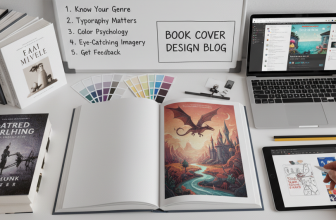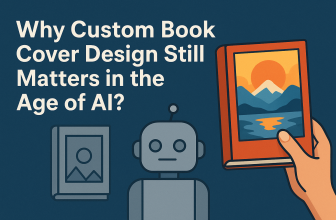
They say “Don’t judge a book by its cover,” but let’s be real — we all do. Whether you’re launching your debut novel or giving your nonfiction guide a makeover, your book’s cover is your first impression. And in the crowded digital marketplace, that first impression can make or break your sales.
From custom book cover design to premade book cover design, there are plenty of creative options out there. But no matter how beautiful the artwork, a few common design mistakes can turn readers away before they even click “Look Inside.”
Here are the 10 biggest book cover mistakes to avoid — plus a few pro tips to stay on top of book cover design trends.
1. Ignoring Your Genre
Each genre has its visual language. Romance covers should not look like sci-fi, and horror shouldn’t resemble cozy mystery.
Avoid: Using a design that confuses readers about what type of story they’re getting.
Fix: Study top-selling covers in your genre. Whether you choose custom book cover design or a premade book cover design, make sure it communicates your genre instantly.
2. Poor Typography Choices
Your font matters. A lot. Fonts that are hard to read, overly decorative, or badly placed can kill your cover’s impact.
Avoid: Using more than 2-3 fonts, cramming text, or picking Comic Sans (just… don’t).
Fix: Use clean, professional fonts with strong contrast against your background. Great typography doesn’t just inform — it sells.
3. Overcrowding the Design
You don’t need to show everything about your book on the cover. In fact, less is usually more.
Avoid: Cluttered visuals, too many colors, or trying to represent every character or plot point.
Fix: Keep it simple and powerful. Let one strong image or theme carry the message.
4. DIY Gone Wrong
Unless you’re a trained designer, creating your cover in Canva or Word can backfire — big time.
Avoid: Pixelated images, poor alignment, or amateurish design.
Fix: Invest in custom book cover design services or choose a professionally made premade book cover design. A polished cover builds trust with readers.
5. Using Low-Quality Images
No one wants to read a blurry, distorted book. And copyright-infringing images? That’s a lawsuit waiting to happen.
Avoid: Low-res stock photos or images lifted from Google.
Fix: Use high-resolution, royalty-free images or commission original artwork. Your cover should look crisp on both ebook thumbnails and printed copies.
6. Ignoring Ebook Thumbnail Impact
Most readers see your book as a tiny thumbnail on Amazon, not full-size.
Avoid: Tiny, illegible titles or overly complex imagery.
Fix: Test your cover at thumbnail size. Can you still read the title? Does the design pop?
7. Not Keeping Up With Design Trends
Like fashion, book cover design trends evolve. A cover that looked modern five years ago may now look dated.
Avoid: Outdated styles, gradients from the early 2000s, or clichéd visuals.
Fix: Research current book cover design trends. Think minimalist styles, bold typography, or abstract illustrations — whatever’s hot in your niche.
8. Neglecting the Back Cover and Spine
Your front cover may grab attention, but your spine and back cover seal the deal — especially in print.
Avoid: Boring or blank backs, or misaligned spine text.
Fix: Include a compelling blurb, reviews, and author bio. Your cover should be cohesive from front to back.
9. Misleading Readers
An epic fantasy cover for a contemporary romance? Not cool.
Avoid: Cover art that sets false expectations or misrepresents your book’s content.
Fix: Be honest with your design. You want to attract the right readers — not trick the wrong ones.
10. Skipping the Professional Touch
Even with great tools and taste, an experienced designer knows things you don’t — like color theory, kerning, and layout tricks that convert browsers into buyers.
Avoid: Thinking of the cover as an afterthought.
Fix: Work with a professional. Whether it’s a custom book cover design tailored to your story or a standout premade book cover design, that small investment can lead to big results.
Final Word
A great book deserves a great cover — one that’s eye-catching, genre-savvy, and built to sell. Avoid these common pitfalls, follow the trends, and trust the pros where needed. If you’re ready to make your book shine on the shelf and in online stores, it’s time to rethink your cover strategy. Because behind every bestselling book is a design that dared to get it right.







